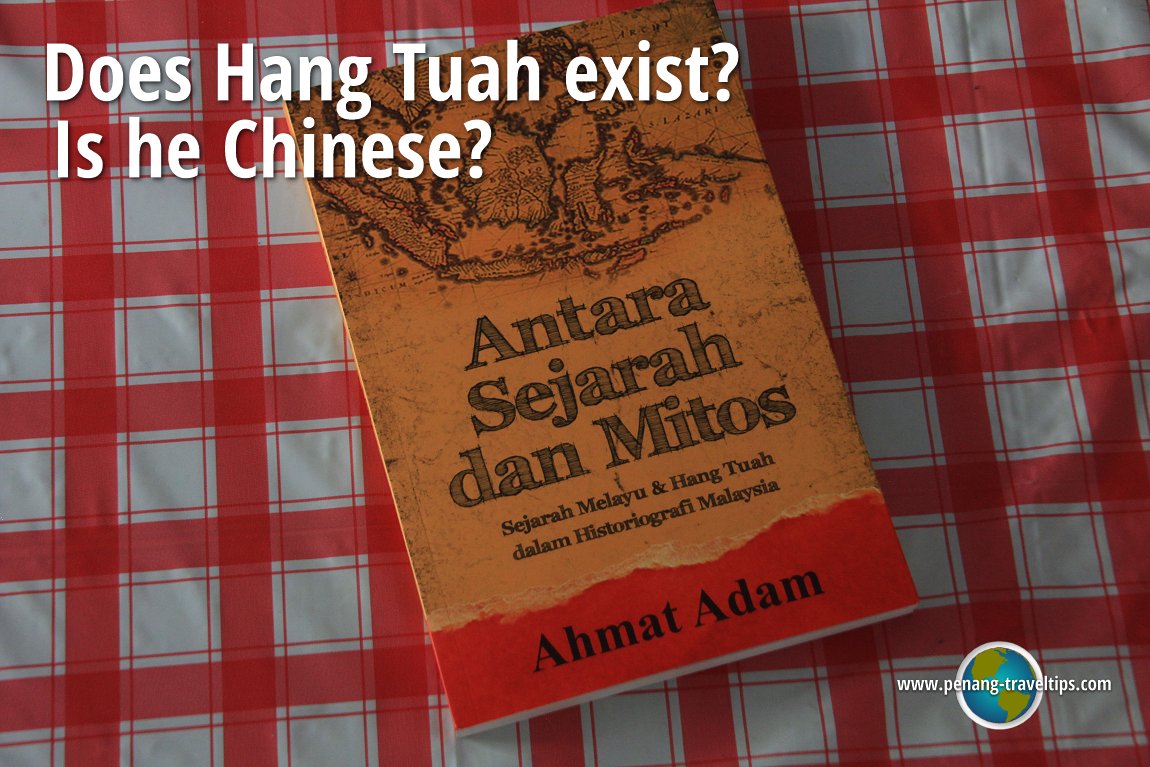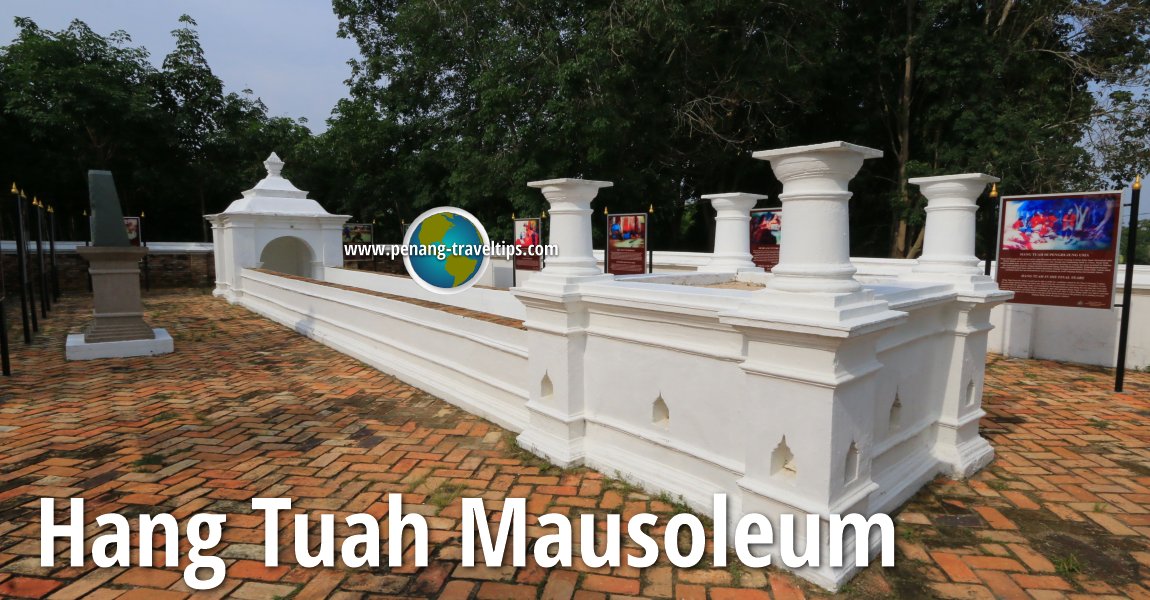 Does Hang Tuah Exist? (8 October 2016)
Does Hang Tuah Exist? (8 October 2016)
Book Review: Antara Sejarah dan Mitos
Title: Antara Sejarah dan MitosAuthor: Ahmat Adam
Year of Publication: 2016
Publisher: Strategic Information and Research Development Centre (SIRD)
Distributor: www.gerakbudaya.com
Review Date: 8 October, 2016 I have known of Hang Tuah all my life. I grew up reading about his exploits. In recent times, however, there has been arguments being put forth on social media and elsewhere, that Hang Tuah is not real and he does not exist. On the other hand, there are also counter arguments saying that Hang Tuah does exist and that he is Chinese. On social media, everybody and his cousin can put forth a claim without a need to substantiate, and somehow gather a following of people who believe what they want to believe. The desire to believe, and to hang on to a belief, is often stronger than the truth.
I did not pay much heed to the rumours flying around about Hang Tuah until a few weeks ago, when I explored the various places of interest in Malacca, and as part of my itinerary, I visited the mausoleum claimed to hold the grave of Hang Tuah. As I toured the well-tended grounds, my mind was racing over the claims and counter claims. Does Hang Tuah exist? Is he Chinese? How do I get to the bottom of things?
Hang Tuah Mausoleum
This is the so-called Hang Tuah Mausoleum at Tanjung Keling that I visited, and from there, the desire to find out about Hang Tuah.Details
When I posted my photo of the so-called Hang Tuah's Mausoleum in the Malaysian Heritage and History Club's Facebook Group, it opened up a deluge of responses, but the one most helpful - and the first of all the comments - is by Mr Shariman Zainal Abidin, who suggested a book to me. I am glad to say that this book, Antara Sejarah dan Mitos, helped me get to the bottom of things.
Antara Sejarah dan Mitos was written by Professor Emeritus Dr Ahmat Adam. The Melaka-born Dr Ahmat is the history professor at Universiti Kebangsaan Malaysia. He has been, among others, a Fulbright Scholar and was involved in the Maritime Silk Road project for UNESCO. His credentials aside, I realise this is a book I could trust when I read in his preface, where he stated: Sejarah menekankan objektiviti dan sikap tidak memihak kepada sesiapa, tetapi sebaliknya menceritakan yang benar sahaja. (History stresses on objectivity and the aim of not siding anyone, but rather to state only what is fact.)
Dr Ahmat based his research on the various versions of Sejarah Melayu that are in existence, the most important of which being Sulalat u's-Salatin, from 1798. A facsimile of this tome is kept at the Oriental Manuscript Institute Archive in Saint Petersburg, Russia, and Dr Ahmat had the privilege of studying it, thanks to Prof. Dr. E.V. Revunenkova.
With that said, Dr Ahmat takes the reader on a journey of enlightenment, so that he the reader will henceforth be able to separate what is history, and what is myth. All too often, the people at large tend to accept claims that are tossed at them as fact, without the provision of evidence to substantiate. This should not be. One should develop a questioning mind, not because one is argumentative, but rather, because one is passionate to know the truth.
As a reader, whenever we come upon something we do not fully understand, we tend to skip over it. But we do so at our own peril, for we are no longer getting 100% of what the writer intends us to know.
The first clue to whether Hang Tuah exists comes pretty early in this book. In fact, it is in the Preface itself, where instead of writing "Hang Tuah", Dr Ahmat wrote Hang Tuah [sic]. What's that [sic] thing? "Sic" is short for the Latin sic erat scriptum. It means the preceding word has been misspelled, but shown as it is (typo and all).
Huh? There is a misspelling and the misspelling is the word Hang Tuah itself. In other words, the person whom we all know as Hang Tuah, was not originally known as Hang Tuah. It's like, somewhere along the journey, there was a junction where someone has taken us down a wrong turn, and we are now standing at the dead end. But only those who pay attention know they are at a dead end.
If Hang Tuah is a misspelling, what should it be? To answer that, we have to understand that the Malay language has not always been in the romanised form. Right up to the 20th century, much that had been written in Malay was in the Arabic script, Jawi. And even there, the Jawi of the 20th century is different from the Jawi of the 17th century and before, which reflects a heavy influence of Kawi (Old Javanese, pg 25). A researcher should therefore read Jawi text mindful of when it was written. The characteristic of Jawi text of the 17th and even 18th century, is that it does not stress on vowels and diphthongs. A reader of Old Malay Jawi text has to be able to decipher a string of consonants, for example, k/y/d h/n/d/y, or in Jawi, كيد هندي, and insect the necessary vowel sounds, in this case the /a/ and the /i/ sounds, and read it as "kaid Hindi". He has to correctly "fill in the blanks", so to speak, and read what is expected of the consonants.
In all the different versions of Sejarah Melayu, the Jawi for the word Tuah توه, comprising the letters ت (t), و (w) and ه (h), should be read "Tuha" or "Toh". It means "tua" (old), not "tuah" (good luck). But in addition to meaning old, the word tuha, as appearing in Kawi, or Old Malay, also means leader, head or group chief. From the word tuha, comes the Old Malay word datua, of which is derived the title for leaders, datu or datuk, which means dignitary, or ketua (leader).
There is so much that Dr Ahmat has written in this book that carefully dissects history based on facts without prejudice. What I can write here represents the tip of the iceberg.
But does Hang Tuah exist? This is what Dr Ahmat said (pg 182): "Pendapat yang dipegang sehingga kini bahawa Hang Tuah [sic, Hang Tuha] ialah nama pahlawan Melayu yang gemilang ternyata silap kerana bukan sahaja ejaan Jawi untuk kata "Tuha" telah tidak dibaca dengan betul, tetapi yang menyebabkan dakwaan itu lebih mustahil lagi bagi sesiapa pun pada zaman sekarang untuk mengetahui nama Laksamana Melaka kerana pengarang Sejarah Melayu sangat mematuhi adat pantang larang dalam penyebutan nama pembesar. Nama Tuha pun sebenarnya hanyalah satu nama gelar. Mitos Laksamana Hang Tuha dengan petualangannya pun hanyalah sebuah kisah mitos yang telah dicipta oleh pengarang Sejarah Melayu."
(The opinion held that Hang Tuah [sic, Hang Tuha] is the name of a glorious Malay warrior is clearly mistaken, not only because the Jawi spelling for the word "Tuha" was not correctly read, but also, what makes this statement impossible for someone of this present age to know the actual name of a Malacca admiral is that the author(s) of Sejarah Melayu has been very cautious to observe customary taboos to never mention dignitaries by name. The name Tuha is actually a title. The myth of Admiral Hang Tuah and his adventures is merely a mythical tale created by its author(s).)
In a nutshell, Dr Ahmat says that Hang Tuah does not exist.
But if he does not exist, why did the author(s) of Sejarah Melayu create him in the first place? Dr Ahmat has this to say: (page 191)
Tidak dapat dinafikan cerita tentang Hang Tuah [sic] yang tersebar ke serata pelosok Kepulauan Melayu memang sangat popular. Akan tetapi, kisah petualangannya itu adalah semata-mata bersifat sebuah cerita rakyat atau folklore Melayu yang tersebar melalui Hikayat Hang Tuah, sebuah karya yang ditulis atau mungkin juga disalin pada ketika Belanda telah menakluki Melaka, selewat-lewatnya pada akhir abad ke-17 pada ketika zaman kemegahan dan kebesaran kesultanan Melayu telah lupus.1 Pengarang Hikayat Hang Tuah itu pastilah seorang sasterawan kreatif yang jempolan kerana berjaya mengisi satu aspek daripada keperluan psychic Melayu yang merindui zaman kegemilangan Raja-raja Melayu yang telah hilang.
(It can't be denied that the tales of Hang Tuah [sic] are exceedingly popular throughout the Malay Archipelago. Nevertheless, all these adventures are but Malay folklore spread through Hikayat Hang Tuah, a literary work that was written or possibly copied during the time after the Dutch conquest of Malacca, at the latest being the late 17th century, when the glory days of the Malay sultanate were all but gone. The author of Hikayat Hang Tuah is most commendably a topnotch writer who has successfully filled a void in the Malay psyche longing for the good old days of the Malay rulers.)
But what about that mausoleum at Tanjung Keling? If Hang Tuah does not exist, whose tomb is that?
Dr Ahmat has this to say (page 186):
Barangkali atas perhitungan untuk mempromosi pelancongan di negeri Melaka sekarang ini, bukan sahaja kubur Hang Tuah [sic] telah diuar-uarkan sebagai tarikan pelancong, tetapi kubur Hang Jebat dan Hang Kesturi pun kononnya telah dijumpai dan dipugar supaya menampilkan wajah "makam". Juga tidak dinyatakan ialah atas dasar apakah kubur ciplakan itu dikatakan kubur Hang Jebat atau Hang Kesturi. Mana buktinya?
(Perhaps for the sake of promoting tourism in Malacca, not only Hang Tuah's [sic] grave, but also Hang Jebat's grave and Hang Kasturi's grave have supposedly been discovered, restored, and given a "mausoleum" makeover. No explanation is provided over how these plagiarised graves belong to Hang Jebat or Hang Kasturi. Where is the proof?)
Dr Ahmat does put out to dry the person who "manufactured" Hang Tuah Mausoleum. That would be UKM archaeologist, Professor Emeritus Dr. Nik Hassan Shuhaimi, who (page 187) attempted to proof that the long grave at Tanjung Keling is the grave of Hang Tuah [sic]. In his academic paper (Nik Hassan 2014: 23-40), Dr Nik Hassan provided the following arguments:
1. The grave is extraordinarily long, thus it is not the grave of a commoner (Nik Hassan 2014:35)
2. The Shellabear version of Sejarah Melayu mentioned Hang Tuah [sic] dying and was buried by Sultan Mahmud at Tanjung Keling (Shellabear 1957: 182, cetera 28th)
3. Ceramic shards from the early Ming and Sawankhalok dynasties (14th-15th centuries) were found in the structure of the grave. Nevertheless, the structure was built during the Dutch administration.
4. A pair of tombstones made from hill rock were found with Jawi inscriptions that could no longer be deciphered. No such long grave like the one at Tanjung Keling has been found.
Clearly, a critical evaluation of the arguments put forth by Professor Emeritus Datuk Dr. Nik Hassan would find the arguments wanting and unacceptable. Or in colloquial speak, tak boleh pakai. According to Dr Ahmat, first of all, the long grave at Tanjung Keling is not the only long grave in this region. There are long graves at Bukit Cina (incidentally, he spells it Bukit Cina, not Bukit China; I would love to hear his argument why) and Pulau Besar too. These graves have been venerated as shrines by the locals since the 1950s.
Secondly, the discovery of ceramic shards has no connection to the long grave, but rather points to the possibility that Tanjung Keling was a settlement or a trading centre. The claim over the tombstones likewise raises concern, because local archaeologists have never performed any scientific experiments to ascertain their actual age. Even Professor Nik Hassan himself admitted that the tombstones are not of the design of tombstones of that particular period.
The attempt by Professor Nik Hassan to establish correlation between the Mandi Safar fest as a means to ward off Portuguese suspicion over local pilgrimages to Tanjung Keling to visit the grave, and also the use of Mandi Safar to hide the existence of the grave, does not make sense, coming from an intellectual who is expected to exhibit rational reasoning, more so an archaeologist. There is no proof to show that Mandi Safar was practised during Portuguese administration. Dr Ahmat regarded the idea as ridiculous (page 189). He has attended Mandi Safar from the mid and late 1950s, and has never visited the long grave in this connection.
Many people without critical thinking have thought that the Sejarah Melayu mentioned Hang Tuah being buried at Tanjung Keling. In fact, this only appears in the version of Sejarah Melayu transcribed by Shellabear in the 1890s and published in 1896. However, the Shellabear version is a hybrid text and a latter version from the Sulalat u's-Salatin copy that was transcribed in mid 1798, where there is no such mention. Therefore, a person of critical reasoning will rightly dismiss the credibility of the Shellabear version (page 190).
What about the claim that Hang Tuah is Chinese? Well, when a character is as fictitious as James Bond and Tintin, you can make him Malay or Chinese or Indian or Dutch, or anything you so wish. Obviously, just as Hang Tuah the Malay warrior fills the void in the Malay psyche, of wanting him to be real, he too fills the void in the Malaysian Chinese psyche, of wanting a part of him to be theirs. And this one-upmanship between the various local communities will just go on and on until local society attains true maturity. But for as long as people believe what their hearts yearn to believe, rather than what is factual, we have not reached that maturity.
Dr Ahmat has something to say about people who believe that Hang Tuah exists, or that Hang Tuah is Chinese, and hold on to those beliefs without questioning, and would argue simply to protect what they want to believe. He calls them gullible! (page 190)
Oleh sebab tindakan sewenang-wenang setengah pihak "membikin" sejarah inilah, maka demi kepentingan meluruskan sejarah tanah air, para sejarawan perlu sangat membersihkan sejarah negara daripada unsur mitos. (page 197)
(Due to the penchant of some to arbitrarily "manufacture" local history, it is the duty of historians to sanitize the history of this country of any mythical elements.)
Anybody who is keen to know local history, particularly pertaining to Hang Tuah [sic] should read Antara Sejarah dan Mitos by Ahmat Adam. I commend Professor Emeritus Dr. Ahmat Adam for so eloquently assembling the information, facts and substantiation. Yes, this book is in Malay, so much the better, to communicate to a readership that needs the truth.
The people deserve the truth. They demand to know history that is based on facts that can be supported by evidence. All too often, the people are misled, or allow themselves to be misled, due to their own emotional desires. The authorities whose responsibility is to provide the people a true account of history is doing society a disservice by deliberately distorting history. It is their responsibility to provide the people with a true account of history, flaws, blemishes and all. People of authority who are party to the fabrication, three words are reserved for them: shame on you.
Discussion
To further discuss the book Antara Sejarah dan Mitos as well as to comment on this book review, go to the the post at Malaysian Heritage and History Club's Facebook Group.
Cross References
1. Teuku Iskandar 1996: 292Review of Books on Malaysia main page; list of Book Reviews with Timothy Tye

Copyright © 2003-2025 Timothy Tye. All Rights Reserved.

 Go Back
Go Back